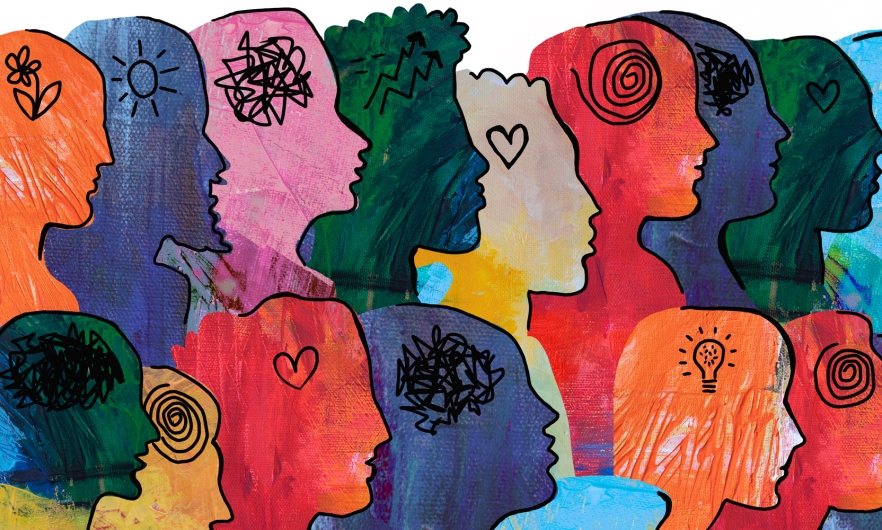What is Public Mental Health?
PMH aims to identify and address the psychological, biological, and sociological factors that influence mental health.

Treating an individual with a mental health disorder typically requires some combination of medication, psychotherapy, and social supports. But how do you address the societal factors that may have contributed to the disorder? Or prevent mental disorders within a population in the first place?
Public mental health (PMH) seeks to answer questions like these by taking a broad, holistic approach to understanding, treating, and preventing mental and behavioral health disorders in populations, says Lindsey Webb, PhD ’20, MHS ’16, assistant research professor in Mental Health.
Public mental health (PMH) encompasses more than diagnosed mental health disorders.
PMH researchers and professionals look at more than mental health disorders like anxiety, post-traumatic stress disorder, and depression, Webb says. “We study so many different areas of mental health and well-being”—including workplace mental health, global mental health, violence, substance use, aging, school-based mental health interventions, autism, and more.
Topics in public mental health also span the life course, from prenatal development through later life. “Being able to meet people where they are, and to address their needs at the different levels of prevention is really key in public mental health,” Webb says.
It’s not the same as clinical care.
While some PMH professionals have clinical backgrounds and training, “we don't necessarily do treatments ourselves,” says Webb. “But we do partner with clinicians to address public health issues.”
In a clinical setting, “you might be looking at the effectiveness of an individualized treatment or medication and handling an existing mental health disorder, like depression or anxiety,” she says. PMH, on the other hand, examines factors that might be playing into the development of the disorder, such as “family and neighborhood and schools … as well as policies or access to services or resources.” PMH researchers then develop interventions to address those factors to be able to prevent the development of those disorders, while other PMH may work with policymakers to ensure that these interventions, in the form of mental health programs and services, are funded and accessible.
Webb and her colleagues work on a lot of school-based interventions, for example. “We might implement a school-based program that's given to all students, regardless of whether or not they have symptoms, to be able to provide extra resources,” she says, so students can avoid mental health issues later in life. Everything from identifying the problems to developing and delivering the programming is an aspect of public mental health.
PMH interventions can have lasting—and even generational—effects.
Webb cites as an example the Good Behavior Game (GBG)—a school-based intervention first implemented with first graders in the 1980s. The GBG is a behavior management approach for classrooms that rewards children for appropriate on-task behaviors during instructional times.
Researchers found it not only to be highly effective at reducing aggression in the short term, but also to have much longer-term impacts as the children moved into adulthood.
"When they were in their 20s, [researchers] saw positive effects on violent behavior, substance use, and a host of other mental and behavioral health outcomes,” Webb says. Today, studies are being conducted on the original participants’ children, to see if the GBG’s impacts have been passed on.
PMH is a constant, ongoing effort.
PMH researchers and practitioners conduct surveys and monitor population trends in mental and behavioral health—such as increases in certain diagnoses or upticks in violence—and pinpoint where issues are arising, what populations they are affecting, and how they need to be addressed.
“With COVID, for example, we saw a lot of worsening mental health among everyone, but particularly among young people—suicide rates increased,” Webb says, “And there was also a shift in substance use over that time.”
Public mental health professionals are everywhere.
Many mental health professionals work in academic settings, but can also be found in research institutions like RTI International and ChildTrends, or government institutions like NIH and SAMHSA. They also work with policymakers, or at the community level in local health departments and nonprofits.
“They work everywhere, because public mental health is part of public health,” says Webb. “Anywhere that public health professionals are working, public mental health professionals are.”
PMH emphasizes equity.
Mental health is still stigmatized in many different populations and can prevent people from accessing preventive or intervention or service, says Webb. Another barrier is costs—of health insurance coverage or of implementing prevention programming. Transportation can also be an obstacle, if people live in more rural areas.
PMH works to dismantle these barriers by developing interventions that can reach vulnerable populations. For example, a PMH approach called CETA trains people without specialized mental health training to provide counseling to people in crisis. And PMH professionals advocate for policies at all levels of government to make prevention and intervention accessible.
What does public mental health look like in the field?
Webb is currently involved in several research endeavors, including Resilience in a Stressful Era (RISE) Baltimore. The project is following a cohort of young people who live in Baltimore City over the course of four years using surveys and interviews with them and their parents to understand how different race-related stressors and traumas impact their mental health and well-being over time.
Webb has also been studying how police violence and interactions impact the mental health and well-being of young people, both in Baltimore and in rural West Virginia. “A lot of this type of work has been done in urban settings, so we have a really good understanding of what's going on there,” Webb says. “But not so much about what policing of young people looks like in more rural settings, and how that might have different impacts.”
Morgan Coulson is an editorial associate in the Office of External Affairs at the Johns Hopkins Bloomberg School of Public Health.





